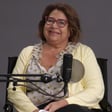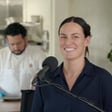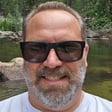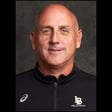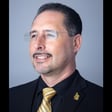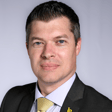Become a Creator today!Start creating today - Share your story with the world!
Start for free
00:00:00
00:00:01

"Every picture tells a story"
University photographer Sean DuFrene talks about how his photos help tell the CSULB story.
Transcript
Introduction to 'At The Beach'
00:00:17
Speaker
Hello, I'm Dan Montoya, Vice President of University Relations and Development. Welcome to our podcast, At The Beach. This podcast shares news of Cal State Long Beach and ways you can get involved.
Guest Introduction: Sean Dufresne
00:00:28
Speaker
Today, I'm thrilled to welcome a special guest, Sean Dufresne. If you don't know Sean's name, you definitely will know it. Sean is an award-winning photographer who specializes in conceptual portraiture and lifestyle.
00:00:41
Speaker
As our campus photographer, he plays a critical role in the telling of the university's story, capturing the moments, people, and places that define life across our campus and throughout the CSU system and beyond.
Becoming University Photographer
00:00:55
Speaker
Sean, it is so great to have you here. Lovely to be here. Thank you for asking me. That's great. So in this whole podcast, you do so much great work. if people i don't think people have realized that they've seen your work and that it's you and a lot of the stories that we produce and the websites that we create and a lot of the pictures and photos you see across campus.
00:01:21
Speaker
So let's let's go a little bit about to how you got to this point. You've been capturing the essence of CSULB for years. How did your journey as the university's photographer begin what drew you to How you get this role?
First Assignment and Training
00:01:36
Speaker
How I got the job was an old friend and colleague from the newspaper days when I was a photojournalist knew the old associate vice president, which was marketing communications back then. And he needed a photographer. And I guess he reached out to John, my friend, and my friend recommended me. And so I met with the old AVP.
00:01:58
Speaker
over coffee and he emergency hired me in. I think my first gig was going to DC to photograph Long Beach College Promise students meeting with congressmen and women and then went right into commencement. So it was like trial by fire, pretty much. What do you remember about that time? Like, Is there a particular picture that you remember from that time that you took that was just like, I got it. I got the picture. Those pictures came after I kind of got my legs about me here. That initial first few months was figuring out how this all works, if that makes sense. Yeah.
00:02:35
Speaker
You know, I mean, I thought it was ah pretty interesting. It almost felt like I was being auditioned by being flown out to D.C., which I was super cool with. Yeah. And then going into commencement, I think if I hadn't had the photojournalism training and grad school training and had been doing, you know, creating photos for a while before that point, I think it would have been pretty intimidating for somebody fresh out of college to kind of hit the ground running with those two assignments specifically.
Conceptual Photography Journey
00:03:04
Speaker
Right.
00:03:05
Speaker
But the to answer your question, the photos that kind of started to stand out to me more were when I could start utilizing ah more conceptual approach to photography, which is calling on ah grad work, like what I did in ah art school for my master's of fine art. And I think the first one that stood out was I was supposed to photograph a star water polo player and had complete freedom to figure out how to do it. And so I got in the water with him.
00:03:31
Speaker
Wow. Photographed him. And I remember the way the shadow hit his face kind of reminded me of like, probably didn't look like it, but in my mind, it reminded me of like Spartan masks. So it like worked perfectly. Really? And then um after that, I started asking if I could create photos for beloved holidays. i didn't really want to do Christmas because it's kind of heavy handed and everybody's house is decorated. And it's a tricky holiday because not everybody celebrates it and stuff, but everybody seems to be on board with Halloween, regardless of religion and stuff.
00:04:00
Speaker
So one of the first ones I did was, and this is where I learned about figuring out your network around here and getting to know people and asking questions, hey, you know, can I borrow this space or do you have any prop students that would be willing to help me out or whatever? Because this campus is amazing. It's just like a treasure trove of everything you could possibly need for a foot for a photo if you or for any kind of art if you like know where to go and who to ask and everything.
Choosing Photography over Other Careers
00:04:26
Speaker
Right. And so I went to the theater department and met the ah props, I guess, master, the guy that was in charge of all the like wardrobing and both of them. There was a prop guy where they build all the sets for the theater.
00:04:37
Speaker
And then there's a guy down in the basement. He's no longer there that was in charge of all the wardrobe and stuff. And they literally built costumes. Right. Which was amazing to me. You opened up a door and it was like, you ever see the cartoons of Bugs Bunny where it goes in the teepee and it's like a mansion inside? you're like, whoa, the spatial difference of outside to inside is very different.
00:04:53
Speaker
Kind of felt like that. Wow. And this guy had shoes that from every generation or whatever, every like genre going back like 30 years. And this, it just, he just had a ton. Right. And then there was a, yeah you know, makeup props too. I ah got the idea from an old Misfits album where it's a woman, I believe, holding like a martini or a wine glass up and through the glass you could see her skull. But on the outside, it looks like a normal human right for Halloween. So i' recreated that.
00:05:19
Speaker
now though It was like stuff like that that were kind of memorable where I was like, oh, wow, like this is available to me, yeah you know, to do this, even though it's going to live maybe on the homepage for three days. That was a pretty fun assignment. That's awesome.
Storytelling Through Photography
00:05:31
Speaker
Yeah. Yeah. Cool. So you and I had talked about ah our love for food and you said you once considered being a chef, which I'm not surprised because, you know, it's ah it's a form of art, right? so what So what made you choose photography instead and how does your passion for storytelling translate to the work behind the lens? And so what I what i really want to get from you is not not just a technical perspective, but the thought process behind it because being a photographer – is not easy a lot of people think that you just take it take a camera you you look at something and then and then you snap the photo and then there you go but there's so much intentionality with every picture that you take and unless you
Career Path and Inspirations
00:06:14
Speaker
have the trained eye you don't know what to look for so maybe talk about that because there's there's a lot more depth to that than people would realize
00:06:24
Speaker
There are always three loves of my life as far as career and where I was headed. Soccer, or in some people's case, football, ah photography, and cooking. And soccer was first. And then I realized that, you know, I wasn't really going to go anywhere. Plus, I think due to the time, I'm a product of a latchkey kid. You know, mom and dad got divorced, 80s, the whole thing and stuff like that. So there was no, there was no push from my parents through the weird years of your life, like middle school, high school to like stay on track. Right. So that went to the side and then being competitive, you know, when I really got back into it, I realized I wasn't as good as everybody else. So that like wasn't fun for me, but photography started, took a few classes. My first class was in high school, went into junior college studying it. And at that time it was still film and
00:07:11
Speaker
I remember I just got super intimidated by National Geographic photographers and their ability and what they were doing. And it was just like overwhelming and yeah crazy. So I pivoted out. I didn't really pivot out. um I moved out and lived in Bend, Oregon for a while, worked at a restaurant. That was the first time I ever saw anybody wear the white uniform with the toque, the chef's hat and everything like that. And I was just like, wow, what is that? I want to do that. right you know i was i grew up cooking and stuff. I always made pancakes and spaghetti and stuff like that. And my mom always made homemade meals and stuff. Went and did that for a while, I think, and just kind of worked all those spots in a restaurant.
00:07:49
Speaker
my dad was My dad was the one who ended up raising me when my parents split up and everything. And my dad was a very practical man. And he was always like, I was like, I'm going to go to culinary school. And he's like, why don't you go cook for a while? And because it's expensive before you. Right. Make the investment. Right. Right. See if you really want to do that.
00:08:05
Speaker
You know, and that's what I went and did and started at the Waterfront Hilton Beach Resort in Huntington. Yeah. piped butter rosettes for two weeks every day. i had the softest hands in the world and then just kind of moved on and i ended up in pastries and all this kind of stuff. So it was really cool. I'd worked other parts of restaurants, front of the house, food runner, bus boy, server, bartender, bar back. And don't know, trying to make a long story short. So it ran around 9-11 time. That seemed to be the marker that I remember when I switched back into photography, like specifically was like, I'm going to go and
00:08:36
Speaker
you know, major in this other thing and not do cooking anymore or restaurants anymore. It kind of just got to a point where i was working down in Dana Point in the St. Regis for a pretty high-end restaurant. And no disrespect, Dana Point, but back then, like some of the people that would come in and they get drunk, they get, you get a lot of, don't you know who I am?
00:08:56
Speaker
And I wasn't raised that kind of way. Right. That started to get jarring to me. And I figured maybe I should pivot out of this was kind of making me ornery. So I went and looked into photography. I was at Cal State Fullerton. I was pretty close to getting my degree in entrepreneurial management business degree. And i was like, I need to get out of this.
00:09:14
Speaker
And so I started studying communications with a focus of photo communication. So photojournalism, essentially. Okay. which wasn't a really but well built out program, but it was something. Right.
00:09:25
Speaker
And then the guidance counselor was like, you know, seven more credits and you'll have an economics degree. So I ended up double majoring in economics and photojournalism, essentially. And then applied to a ton of newspapers and started freelancing at like, you know, for the local newspapers, got hired down in San Diego at the San Diego Union Tribune. Well, one of their small papers first and then got brought into the San Diego Union Tribune, got laid off early.
00:09:47
Speaker
And then that was grad school. So photography to kind of give you an idea, i always wanted to be a documentary photographer. And when I worked for, even like at the beginning time, when I got intimidated by national, I wasn't really inspired by national geographic, but I've always kind of had an overactive imagination.
00:10:03
Speaker
So I didn't really realize that one was sort of related to the other kind of a thing. Yeah. And yeah, I got laid off. Um, and it was either join the military or go to
Grad School Transformation
00:10:12
Speaker
gro grad school. Wow. And I was like, very interesting option.
00:10:15
Speaker
Yeah, well, I was a little irritable about being laid off of my dream job. um My philosophy back then was like I would have gone to Iraq for free for them. I wanted to go and be a war photographer. Wow.
00:10:26
Speaker
So I wanted to see that, experience it, photograph it, the whole thing. And I, you know, probably looking back on it, I'm glad nobody called me on that and said, OK, you know, you should go do that because...
00:10:37
Speaker
That could change a person's mind a bit. And probably better I didn't do that. I thought it was like God's gift to you because I would have worked for free pretty much. you know That's where the military thing came in. But then I thought about it and I was like, I think i'm going to be a handful for the military. Maybe I shouldn't do that because I think I'm and just going to annoy me, meaning I'm going to end up annoying ah cat a somebody above me by questioning or asking too many questions or...
00:11:03
Speaker
getting to the root of a whatever and that kind of a thing. And I'm like, maybe I should just go to grad school. That might be a better place for me. And then grad school, like, lined up, like I was saying, the overactive imagination of the documentary. That's where I learned where you can blend the two.
00:11:17
Speaker
You know, I remember walking in the director of photography's ah office one time, and I was like, am I doing enough here? All I seem to be doing are taking photos, and where the tests and the Blue Book essay answer questions and stuff like that?
00:11:30
Speaker
And he's like, you shooting photos? And I'm like, yeah. He's like, good. That's all you got to do. And I'm like, God, this is the best thing ever. Hey, kids out there, grad school's great. You should go to grad school.
Photography Philosophy: Quality and Style
00:11:40
Speaker
So that was a pretty amazing experience. And because I knew very well how much it was costing me with student loans, I likened it to, i just kept thinking about how do people like, how did Michael Jordan train to be good? Great.
00:11:57
Speaker
yeah How does LeBron change train Kobe? You know, Why are they great? Why are they standout names? I saw that time period for me as like train like them. Right. You know, yeah eat, sleep, drink, breathe.
00:12:10
Speaker
Nothing but photography. Yeah. You know, you you already had your go at the newspaper. You got laid off. Get into it, man. Be all you can be. That's right. And so my walls were covered with advertisements that I really dug, not because of the product they're selling, but because of the art that was created for it. And I just stared at it all the time and I tried all these crazy ideas. And yeah, I just, I think I shot probably, well, pretty much all my personal work is a lot of it's from that time period. Yeah.
00:12:37
Speaker
Because I just was constantly coming up with ideas and trying this and pivoting and then turning that into a series and There were times when I was like, oh, that's a stupid idea. People are going to think you're dumb or crazy or whatever. But then I was like, whatever, you know, this is his art, man. I guess this is what art is.
00:12:52
Speaker
Yeah. You know, art's very subjective. It is. And so then I realized at that point that you could probably figure out how to do that, but dial it back a little bit, which is what I strive to do here at the university. Yeah.
00:13:06
Speaker
I'm in full awareness that I can't do the rated R stuff. I did it, you know, in art school here at the university. And I'm fully aware that my job is to basically be a cheerleader for the university
Capturing University Events
00:13:18
Speaker
visually. However, i do feel my philosophy about photography here at the university is why can't we look like a Vanity Fair or a Vogue?
00:13:28
Speaker
Sometimes I think a lot of other universities, and I mean no disrespect and I'm not going to name names, but they feel more like People Magazine. And there's nothing wrong with People Magazine. It's just my philosophy of it. I feel that kind of gets rooted back to my time working at a newspaper. There was always a ton of analysis of what's the most important thing, the headline or the photo that lives above the fold on the newspaper. And since I was part of the photo department, I was always team photo.
00:13:54
Speaker
right So I was always striving to create a photo that would end up above the fold, that would entice somebody to pick up a newspaper and want to read the story. So when you choose a photo, and let's say you're very similar to newspaper, right?
00:14:11
Speaker
In the newspaper, you're like thrown into a story, right? Like, hey, here's the scene, photograph it in time. But in our world, in the university, you almost get to create what the scene is, right? Because I know you you do that with commencement. You do a wonderful job. i you know Thank you. The exec team always loves the photo that you take of us, and it's always different every year.
00:14:31
Speaker
But there's so many cool photos during commencement, but then there's other events, right? And now you're in a position where you're actually creating the scene rather than than walking to a scene, right? So talk to us about that. Like when you're when you're looking at it and and you're setting up, you know, there's like, you're looking for a certain light, you're looking for a certain visual. There's so much that you're looking to set up to get the right shot. Yeah. I think that it starts with what is the assignment? Is it ah an event that I need to cover? Or is it something that's open for creative input? When I say creative input, it's like going back to that water polo portrait story, yeah you know? Usually profiles that necessitate a portrait, it's usually that's more on the creative side. And that was always the case of the newspaper too. Yeah. You know, but even with events, sometimes I'll get a little bit in a rut because you cover so many events and then I'll think to myself, how can I cover it differently? How can I approach this differently? You know, I think after eight years of being here, I've come to realize that the happy smiley pictures are the preferred ones. You know, i don't think like catching people in like, you know, there's this famous photo of Marilyn Monroe that ah iconic photographer Richard Avedon created where she was turned off, meaning she wasn't Marilyn Monroe for a minute.
00:15:45
Speaker
she was always on for the public and that's how we knew her. But he caught her sitting at the foot of a bed, just sort of like in a, in a mindless moment of like, I'm just, just give me a second, you know? And that's what usually ends up in that photo is like in his portfolio or, and you know, we ends up in the museums and stuff. And,
00:16:03
Speaker
When I first started, I was always trying to find stuff like that at events, you know, in between moments. And then I've come to realize that sometimes in between moments can be vulnerable for people and thus perceived as unflattering. And I, you know, unless it's an extraordinary moment, I'll usually, I'll probably snap, you know, click the button or push the button, I should say, and then probably it won't make it anywhere.
Impact of Genuine Moments
00:16:27
Speaker
But, you know, I documented it, I captured it, the whole thing. But i'm I'm kind of aware that you have to be very confident in yourself to allow that to be seen by a lot of people.
00:16:36
Speaker
And when you're when I'm photographing these, you know, very important people and high end donors and stuff like that. I'm not sure I don't know them well enough to know that. And that and I'm not in a job like if I were here on behalf of Vanity Fair or something like that, it's a different thing.
00:16:50
Speaker
But because I'm an employee here and my job is to make these people look good, feel good, happy. I look for those moments more like the happy moments, smiling, hugging, handshakes, that kind of a thing But like I was saying, getting into a rut sometimes is a problem because then i then I'll see like a movie or whatever and I'll look at like, you know, you know in the good, the bad, the ugly, the close-ups, the extreme close-ups. Yeah.
00:17:12
Speaker
Those always inspired me. And I was like, well, what if you did that in like a really, really nice moment where somebody is just like, you know, smiling wildly, you know, having the best time of their life and you're able to get that close like in a cinematic like close-up, you know. So I'll like shift my brain and try and approach things that way. Regarding the creative side of things, um if it's wide open, start asking myself, what's the story? You know, I'll see if I can get a rough draft to read and glean some keywords out of it to figure out like, where do I want to photograph the subject? What do I want them wearing? What do I want them doing? How many different setups are there? How many setups will they have time for? How many setups will I have? time for You know, i am a one man band, so I'm like operating on my lights and, you know, my cameras and directing and typically on like an editorial shoot or even an advertising shoot.
00:18:02
Speaker
More importantly, you know, that would be a team of like anywhere from like three to 10 people helping out and working, you know, all collaborating, giving creative ideas and things like that. So it's kind of a trying to balance out what do I want to do? What's the vision in my brain? How am I best telling this story?
00:18:19
Speaker
But then also
Essence of Sports and Cultural Events
00:18:20
Speaker
what's realistic? Like, what can I pull off? If it's a windy day and I have like a strobe light on a light stand, I don't want the wind to blow over the light stand because then that's a cost to get it fixed. And that's a bummer. It's a lot of a calculation to figure it out. But at the end of the day, the objective, again, is to get that above the fold photo.
00:18:38
Speaker
yeah I want people to pick up the newspaper, metaphorically speaking. When someone tells me that your photo or your photos directly helped raise money for a program, like you can thread you know yeah the needle or whatever, you can you can connect the dots you know from one to the other. That's like a paycheck to me. Yeah, yeah i I look at when I think about, you know, now that you mentioned the Smithsonian, that I always go back to that.
00:19:04
Speaker
There was a picture of of the Smithsonian and they were in Petra. I remember that too because I've been to Petra and I was in that where that photo was and how real that picture was versus how there was different. And so I've i've also likened that similar to the ones that you took for Project Rebound and some of those, how they're very real and the low writers and some of the other pictures you've taken who that tell not necessarily a happy story or per se, but the reality life. You're telling their story. Life story. Yeah. And that that right there is really great. And then also the the other one that comes to mind is the picture of the runner in front of the pyramid. Oh, yeah.
00:19:45
Speaker
And that that when they're actually running, you can see water like coming up as they run. And I was like, to tv be able to capture that moment and all those details, that is not easy to do.
00:19:57
Speaker
Right. It's it's just one of those things like, you know, with athletes trying to catch them in the moment. Right.
Power of Storytelling in Photos
00:20:02
Speaker
Mm And it's not just that one. You've done others for the powwow. You know, the powwows, the beautiful colors of these costumes and all that, that tell a story of our Native American culture that surrounds the beach and how beautiful it is. And speaking of that, po the powwow is coming up this weekend. yeah And I look forward to seeing some of the photos that you take of that. And it's it's ah again, it's telling the story of Native Americans ah who are part of our culture and who are part of this campus and the surrounding tribal nations around Southern California. So that's really, really cool. But when you tell those stories, i think for me, when I look at that and and people say, that was a great story, but that picture took me somewhere. That picture took me to a place that I never thought a picture would.
00:20:49
Speaker
I think that is what's powerful about what you do. and And that's what's unique about the way you approach the work because not everybody sees it that way, right? Yeah. A lot of people, again, with the mindset of snap, snap, snap. Here's your pictures. Thank you. See you later. But you're more thoughtful in that process to say this picture or you probably snap thousands and then you have to select the one that says this is it. Yeah. The one that captures the essence of everything that we're talking about.
00:21:17
Speaker
Yeah, i think um when you're editing the photos, I mean, so I just photographed the gospel choir. Oh, That's a good example. Yeah, yeah, yeah. Recently. Yeah. um And I'm not, I don't go to church very often. i You know, I believe I'm spiritual. Right, right. I'm spiritual, everybody. But i was just thinking while I was there, God. God, like they they would make a nonbeliever a believer how cool it was. I mean, it was such there's such energy there that I mean, i just remember going to Tracy and telling her that and Jonathan Talberg.
Emotional Connection to Subjects
00:21:46
Speaker
And I was like, I think I just shot 5000 photos.
00:21:49
Speaker
This is going to be a real pain in the butt to edit down. But like it was easy to shoot 5000 photos. And sure enough, when I was going through it and I'm still kind of almost done editing through like colorizing and stuff like that. To your point, one of the newest tactics or newer tactics I'll use when I'm editing, because, you know, editing down from 5,000 photos can take forever in a day if if you allow it to. But if you move fast through the photos and you wait for that one to jump out at you, they always do.
00:22:15
Speaker
Really? And it's like, I can't explain why, but it's like, yeah. oh Oh, my God. Oh, there's that. And so I'll tag those, you know, and it's it's subtle. I mean, it might be like the first three didn't work like because I'll shoot the same thing maybe 10 times. I'll point the camera at the person doing whatever they're doing 10 times, 10 shots, 20 shots or whatever.
00:22:38
Speaker
And I'll move through them really fast and I'll find the right one. And it always jumps out. You know, so A, it helps the editing process. But B, like more importantly, like it's this weird, surreal experience where it gets your attention. And it was always like that at the newspaper, too.
00:22:53
Speaker
And it was like that when I used to study the newspaper. Like I always when I was at the newspaper, I always look at the New York Times and the LA Times and I studied them like they were a textbook. Because they were winning all the awards and they never hired like from a job bank they recruited. And I was like, you must be a baller if you're just going around like, hey, I want you. And the person's like, OK, I'll leave my place and go work for you.
00:23:12
Speaker
you know, yeah um to my understanding that maybe I have it wrong. But I was like, because I was always trying to like, how do we get on that team? yeah That is like an all star team. And I would like my level, my ability would grow yeah drastically if I got to go play on like a really good team.
00:23:26
Speaker
Yeah, it's ah what I was going to say earlier.
Creative Process and Openness
00:23:29
Speaker
I was listening to you talk about the photography and stuff like that. I think because I've been doing this for so long, one thing that I've learned is i think I open myself up to the energy of the event or the story of the person in a very like whole way. I mean, so like powwow. I know minimal about Native American culture because, you know, I don't come from the culture and stuff, but just obvious stuff you see on TV and being exposed to and stuff like that. But When I find myself, when when I found myself at like the last powwow I was at, I'll just kind of lose myself in the moment. And I won't be thinking about, oh, did I take the clothes out of the dryer or, you know, things like that. Like I'm 100% mainlining the vibe yeah from them. And i remember, you know, I'll be hearing...
00:24:13
Speaker
I'm watching, hearing the music, they're dancing, and then they're talking about the history of it and stuff. And all of this is coming at me. And I remember getting teary-eyed of, like, how crappy human beings can be to other human beings. yeah And, you know, and I'm, like, here to do a job.
00:24:29
Speaker
And here I am, like, empathizing pretty immensely with, like, their
Career Reflection and Industry Challenges
00:24:33
Speaker
situation. But I don't know if that would have been the case, like, fresh out of Cal State Fullerton, you know, because you have these other, like, oh, you know, did I put my pants on right or— You know, you're just worried about other stuff that's just non-related. And the same thing with stories, too, with ah portraits and stuff like that. I'll try and understand it. Or like you're talking about sports. I mean, I really try and think about the power of sports. You know, what's proper form, you know, before I'll photograph something. And I'll look for that. If I'll put the camera on high speed, which is like the machine gun firing and stuff like that, I'll find that perfect stride or or hopefully I got it. You know, um nothing makes me more irritable. Well, there's a lot of things that make me irritable, but what makes me usually very irritable is when I see a really high end sport ad campaign and the person has really crappy form or this is my favorite example. And no offense, Gigi Hadid, if you're listening to this podcast, but I'm sorry, you weren't the right pick for the Reebok CrossFit campaign many years ago.
00:25:26
Speaker
i was like, where's your muscle structure? Yeah. And was right around the same time when Wonder Woman came out and there was a bunch of like CrossFit women that were part of her family, which came off the island, whatever.
00:25:37
Speaker
It was part of the news. But then some people were saying, well, why did they cast her? Why didn't you cast somebody with like more muscle? That's an actor yeah that could play the role. And then they came out with the Gigi Hadid. And I'm like, yeah, like people are fantastic what they're doing. And like, sure, she's great for certain things. But I was like, where's her muscle structure? Yeah. So it's like form. I think about form. I think about like power, grit. Like I've gone through a lot of that stuff because I played sports. I work out, you know, the whole lot stuff. I've had physical therapy over like torn ligaments and stuff like that. So, you know, I can empathize and I kind of understand it, but I'll try and understand stuff. Even if it's a professor of like a subject that I don't know, I try and understand it. Sure. So when I get into the mode of photographing them, I'm telling their story.
00:26:20
Speaker
I'm not giving getting heavy handed with my creative idea. Right. You know? Yeah. I was going to ask you, but I think you kind of answered it. Is there a ever a picture that has made you cry? That when you saw it, you're just like, like just emotion because of the moment. Not mine. It could be anything, right? yeah Yeah. Well, one that one that I framed, and I still have framed to this day, is after Katrina, I believe it was an LA Times photographer, captured a little boy in shorts sitting on wooden rubble, like just rubble. no shirt and in the foreground of the photo was like kind of a wet teddy bear and I like and he had his hand his head in his hand and I was like no way you set that up there's no way you found that perfect sad super like bummer like it it just in the and when I say little boy I'm like I don't know four or five years old no one else is in the shot and it's him and his teddy bear and I was like you're coming with me everywhere
00:27:17
Speaker
So I have it like framed and that'll go up once the office and all that stuff, the construction gets done and everything like that. So that's one of them. But yeah, I'll see stuff that I'll get choked up. I get more, I'm, I notice I'm getting more emotional as I get older.
Artistic Interpretation and Personal Projects
00:27:30
Speaker
I'm like, God, what's going on here? I'm getting all teary eyed over this like pharmaceutical commercial. Well, you know, you you you obviously get to experience the passion in the work that you do. Obviously, if you didn't care about it wouldn't move you. But that's the beauty of of what you do is because you're so passionate about it.
00:27:48
Speaker
So when somebody sees your work, what maybe one to three questions do you want to ask them to consider when they're looking at one of your works? So example, like let's say you have, you know, you have a picture and let's say it's of the powwow and you're trying to tell the story and you want them, you want to answer the questions of what is this about? What am i what are you trying to tell me? You know, what should i consider moving forward? What is it that is so special about this? Or is there, is there... points that you would recommend for folks to look at in a photo that would help them see something beyond the image that is in front of them like you just described katrina okay you already put an image in my head you described a little boy sitting in rubble okay you put that in my head you put a teddy bear hu but i'm sure there was i don't know it was a sunny day or cloudy day or whatever But when I look at all that, it's like, what how how can this picture lead my imagination to to figure out the rest of the story, right? Because that picture was so dynamic that not only did it bring emotion to you, but it made you think of everything that was in that image. right
00:29:01
Speaker
So when when we want our folks to look at the work that you do, what what things would you ask them to consider? How much money are you willing to give the beach? Good answer. Good answer.
00:29:13
Speaker
Because we need it. um Honestly, i don't I honestly don't have I'm not looking for if a person has a question about a photo, I'm more than happy to answer. What do you mean?
00:29:25
Speaker
What you what is this? Right. Whatever. Um, but i don't think, I think my photo, like what I do is to a certain degree disposable and open for interpretation.
Supporting University Fundraising
00:29:37
Speaker
okay Um, I work, one of my signature personal projects was this, uh, uh, project I did. I created, you know, it was me interpreting my dad, my interpretation of my dad's personality. Oh, that's interesting. Okay. And um I'm happy I did it because literally about a year after I finished it, I started in 2008 and finished it in like 2011. He ended up passing away. so I was like, well, this is cool that I have this. yeah And it was ah bunch of unique stories and it was right in the middle of grad school. So it was like filled with, you know, some rated R stuff, some rated PG-13 stuff, some PG stuff, blah, blah, blah. But it started out when I got laid off. Yeah. from the newspaper, I made it a point to shoot photos every single day just to stay busy in the craft and keep learning.
00:30:22
Speaker
And then I read an article that Richard Avedon, the photographer I was talking about, he documented ah the dying process of his father, like the last eight years of his life, all the way to like him dead in a gurney. And I was like, well, that's a little too intense for me. I've always had kind of like a happy Candyland game kind of mentality. So i was like, I don't know if I want to get my dad dead.
00:30:41
Speaker
Right. But um And it I say that in a way because it leads to what how the how the sort the project started and then what it developed into. And I'll get to your your point in a minute here. But like um I started out documenting him. And then when i when I would review those photos and it was straight photojournalism, I wasn't manipulating anything. I was like peeking around corners and just catching him in his element and stuff. Right.
00:31:05
Speaker
It was so depressing. Like, I didn't want to see my dad like that. And, you know, every kid or not every kid, but like for me, I had a particular viewpoint of my dad, yeah you know, good and bad and type of a thing. And so I started in grad school. the the The cool thing about grad school is it allowed me the opportunity to, um well, create what's in your brain then, you know, like you don't have to do documentary. It could look like it's real, but who cares? It's art. And so I wanted to. So i the project was my interpretation of him and I remember showing two of the photos at ah like an exhibition and somebody walked up to me and was like, I had no idea it was my dad. And he was like, looks, your looks like you're, it looks like the guy in there is like totally perving out like he's a molester or something.
00:31:48
Speaker
And I was like, you know, the little voice in my head was like, calm down. Don't say what is rifling through your brain right now. you're You're in a public event. And then it was art is open for interpretation, yeah you know.
00:32:01
Speaker
that was one of my first experiences, like firsthand, where I was like, ooh, I could get so angry at this because you're saying what you're saying. But then I was like, well, you know, that's his interpretation. You know, that's not my interpretation. That's not what I meant by it. And I just kind of smiled and was like, all right, cool.
00:32:15
Speaker
And walked away. Right, right. You know, and I feel that that is very much what I do here. You know, if I can get somebody to want to give and I'm not trying to be all team URD, but that's the job. I'm like on the team.
00:32:29
Speaker
You know, if I were playing goalie, I'd want to stop balls from going in the net. Right. You know, if I played striker, I'd want to score goals. if i'm If I can get somebody to give more money or somehow donate, give to the university in some sort of a capacity, then I feel like I'm doing my job. And that comes from, that still, I think, has that philosophy of why not try for a bigger boulder, push the boundaries, show something a little bit different, you know, try and be as edgy as you possibly can, but still within the confines of like... not the confines, but like within the boundaries of what's tasteful here. Right. You know, I don't work for Vanity Fair or
Photography's Role in Development
00:33:06
Speaker
Vogue. They get to get away with a lot of stuff and they get to work with celebrities, which by the way is like marketing on wheels to begin with.
00:33:13
Speaker
I mean, you photograph any celebrity and it's like, oh look at you you photograph you know you have beautiful images in your portfolio you know and this is a whole and nother conversation but the evaluation of what is a good photograph and what isn't a good photograph is sometimes interesting when people are like oh he's got a really great portfolio and it's like a ton of celebrities and i'm like they look great so how much are they carrying the photo and how much it is the technique of the practitioner right you know yeah My job is to get people to give money. So I had a colleague here one time say, you know, i i was telling her, I was like, you know, i don't know if I could do these photos anymore because i don't really know if we can justify it. Like, what am I, I've been doing this for a while and what am I doing? And she literally looked at me and goes, Sean, you have no idea
00:33:58
Speaker
what, how much like your photos have a hand in fundraising. And this was the communicator, not the DOD. And I was like, I need to know that because it helps me. I don't know if it helps me emotionally. It doesn't, you know, put money in my bank account, but it like, it lets me know that I'm doing the job that I'm supposed to be doing. Right.
00:34:15
Speaker
You know? Yeah. So um that helped out a lot. And then it's also a good talking point. If somebody's like, why are you taking the time to do that? I'd be like, she says it helps out with fundraising. So maybe I continue to do this. It's not my call, your call, but I'm just giving you a heads up. Yeah. you know And I think that's right. I mean, I think what we're, it's it's a good point that you bring up because everything we do in the division is really geared toward providing an opportunity for donors to have an impact, right? And so what we want to demonstrate is what that impact is, right? And and I think your pictures demonstrate the impact of what could be if you got involved with the program, with the story, with the characters in the story, or the students, faculty, staff, or volunteers, whatever it may be. so i think i think that's yeah I think you're spot on and you're doing what you you should be doing. So I think that's great. Well, um is there anything you'd like to add before we close this out? And I appreciate you taking the time to really tell of the work that you do and how meaningful it is to the institution. And what else would you like to let people know about you and the work that you do?
00:35:22
Speaker
I don't know. I don't. I try.
00:35:26
Speaker
Always trying. Yeah. You know, sometimes I ask too many questions, but it's truly because I'm trying to figure out my way in whatever I'm doing, you know, the story or whatever. So be patient with me, I guess, people. Oh, good. Well, we know that if if you haven't seen his work, where can they see your work? So I have a website. um It's just my first and last name dot com, SeanDufresne.com and Instagram. I'm not heavy on Instagram. I have particular philosophical beliefs about meta, but you got to do what you got to do.
00:35:54
Speaker
Right. So, yeah, so you could probably you could see stuff on Instagram or you could see stuff at my website. I try. i'm I'm going to have a new portfolio up there for a springtime in hopefully a week or so. You know, I try and change it for the seasons. yeah And then if you're interested in like my background, that's all there, too. In the info section, you can see the resume and hear my biography and my philosophy on photography.
00:36:16
Speaker
Nice. And then we could also see your works on our webpages, our stories. So it's csulb.edu, the homepage. We have a news page, um a lot of the marketing brochures, Beach Book, the social. the There's a lot of social sites here, handles, but um the primary university social. You find stuff there. Yeah.
00:36:36
Speaker
Or you can call me up and be like, hey, can I get a photo? They do headshots sometimes. Yeah, yeah, yeah. Awesome. Well, many thanks, Sean. That concludes another edition
Podcast Conclusion
00:36:46
Speaker
of At the Beach. A special thanks to our colleague at iSpace here at the University Library for sharing their podcast studio with us.
00:36:52
Speaker
I'm your host, Dan Montoya, Vice President for University Relations and Development. And we always like to end our session here with a Go Beach on 3. 1, 2, 3, Go Beach! go beat
